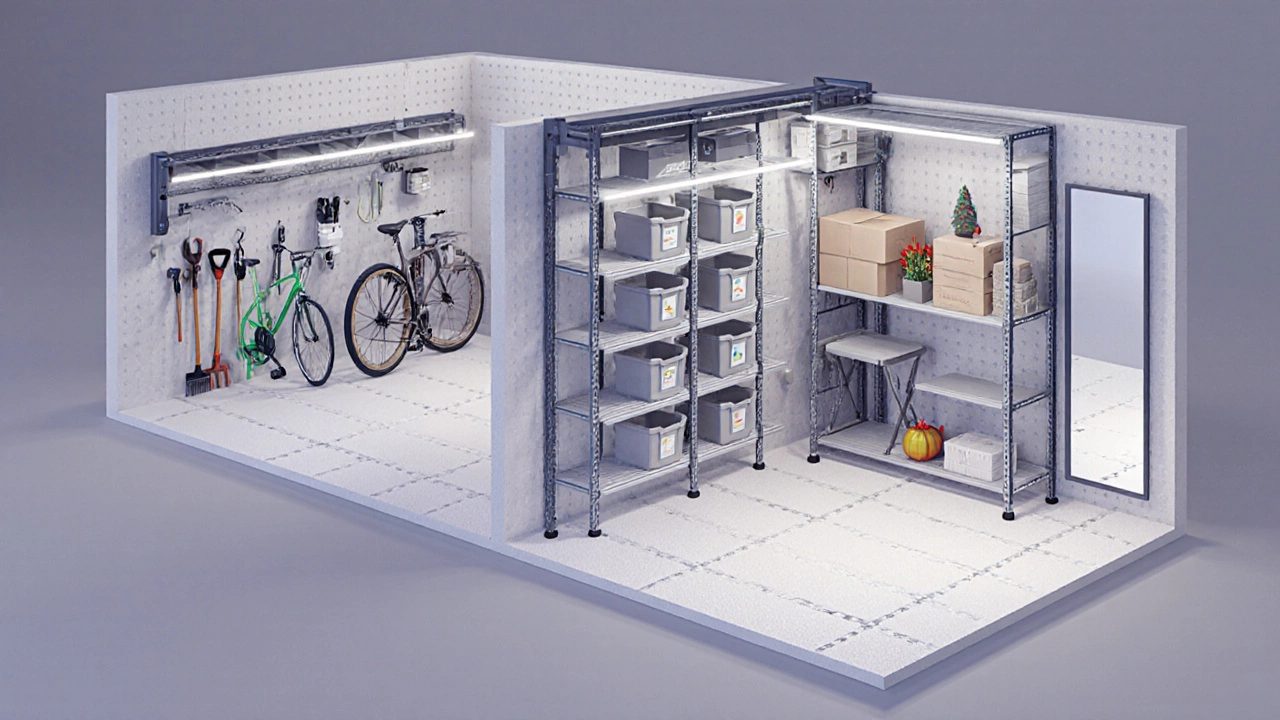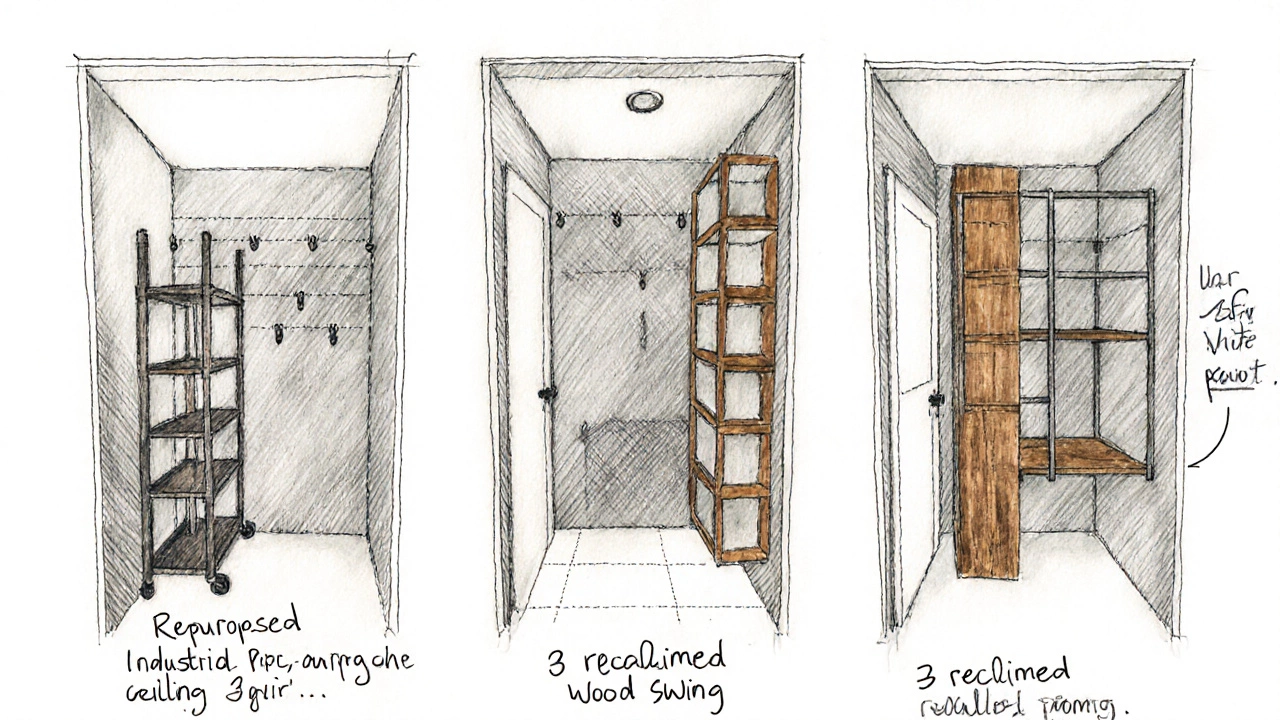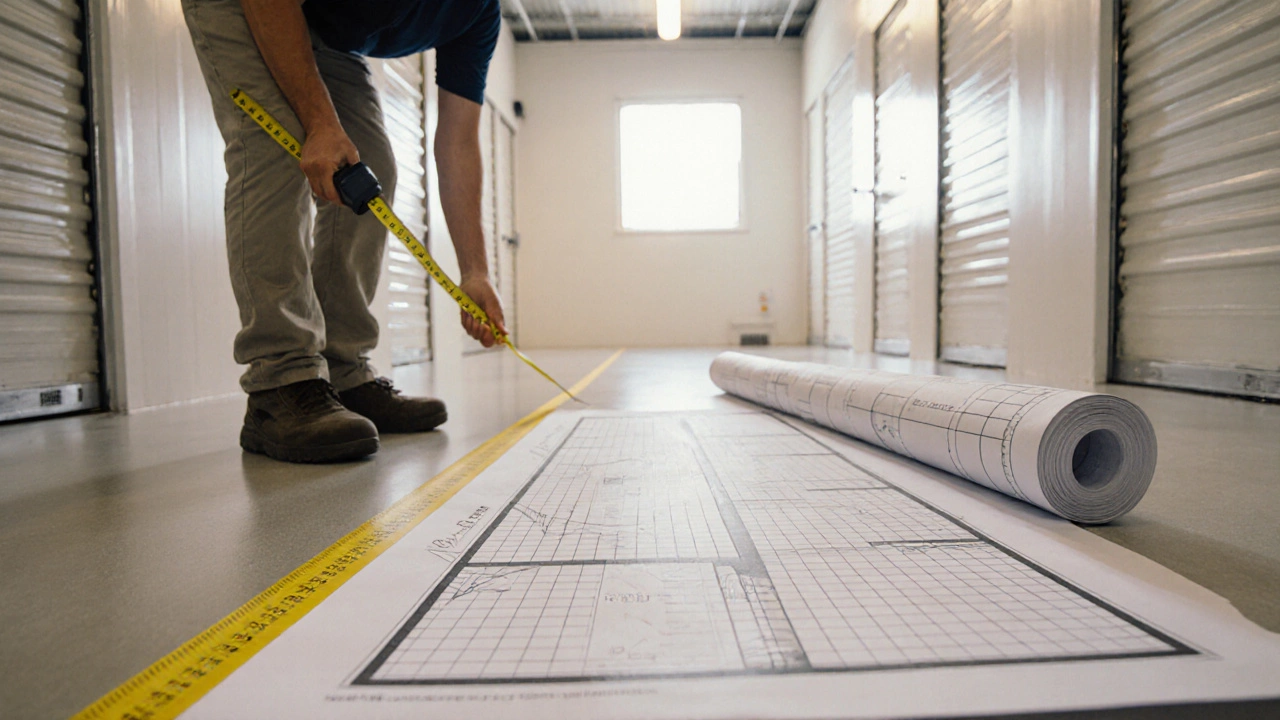5x10 Storage Space Calculator
Calculate how much storage capacity you can maximize in a 5x10 room by choosing different storage solutions. Based on article recommendations for safe and efficient organization.
When you step into a 5x10 storage room a compact space measuring five feet by ten feet, ideal for organizing seasonal items, tools, or extra furniture, the first question is how to make every inch count.
Key Takeaways
- Measure accurately and draw a to‑scale floor plan before buying anything.
- Prioritize vertical storage - ceiling racks and tall shelving units add up to 30% more usable space.
- Mix free‑standing, wall‑mounted, and modular pieces to keep the room flexible.
- Choose light‑reflecting flooring and LED lighting to avoid a cramped feel.
- Invest in adjustable systems; they grow with your storage needs.
Understanding the 5x10 Space
A 5×10 room gives you 50sqft of floor area. That sounds small, but when you factor in height (usually 8ft in a residential setting), the total cubic volume is 400cuft. The trick is to treat that volume as a series of layers: floor, mid‑level, and ceiling.
Start by sketching the room on graph paper - each square equals one foot. Mark doors, windows, and any built‑in obstacles like a heating vent. With a simple layout you can spot dead zones where a shelf would block a door swing or where a hanging rack would clash with a light fixture.
Core Layout Principles
Three rules keep a 5x10 room functional:
- Zone by use. Group similar items together (e.g., gardening tools, holiday décor, sports gear). This reduces rummaging time.
- Leave a clear pathway. A minimum 2‑ft aisle lets you maneuver a small cart or lift heavy boxes safely.
- Balance weight. Heavy items belong on lower shelves or the floor to keep the room stable.
Choosing the Right Storage Furniture
Here are the three most common approaches, each with its own pros and cons.
| Type | Cost (USD) | Installation | Flexibility | Load Capacity |
|---|---|---|---|---|
| Free‑standing Shelving unit adjustable metal or wood shelves | $150‑$350 | No tools, just assemble | High - can be moved anytime | Up to 300lb per shelf |
| Wall‑mounted Wall‑mounted hooks heavy‑duty hooks for bikes, ladders, etc. & Ceiling‑mounted rack track system that lifts items to the ceiling | $80‑$200 | Drill holes, anchor securely | Medium - fixed after install | Up to 200lb per hook, 400lb per rack |
| Modular storage system interlocking cubes and panels | $250‑$500 | Snap‑together, minimal tools | Very high - reconfigure anytime | Varies by module, typically 150lb |
Free‑standing shelves are the easiest starter option. Wall‑mounted hooks and ceiling racks are perfect when floor space is at a premium. Modular systems shine if you anticipate frequent re‑layout - for example, switching from holiday décor to summer sports gear.

Maximizing Vertical Space
Vertical storage adds the most bang for your buck. Here’s how to stack it smartly:
- Install a Ceiling‑mounted rack track that lets you roll bins up to the ceiling. Use clear bins with labels - you’ll see everything at a glance.
- Hang Wall‑mounted hooks for garden tools, ladders, or folding chairs at eye level to keep them reachable.
- Choose ultra‑tall Adjustable shelves that can be set to 6‑ft heights. Store rarely‑used items on the topmost tiers.
Flooring and Lighting Tips
A dark floor can make a room feel smaller. Light‑colored vinyl or interlocking foam tiles reflect more light and are easy to clean. If the room sits on a concrete slab, lay down a thin rubber mat to protect both the floor and your stored items.
Brightness is just as crucial as color. Install a pair of LED lighting energy‑saving strip lights with dimmer control along the top of each shelving unit. The extra illumination reveals the contents of upper bins and reduces eye strain.
Sample Layouts
Free‑Standing Shelf Focus
Place a 4‑ft tall, 2‑ft deep shelving unit against the far wall. Keep a 2‑ft aisle beside it. Add a rolling Storage cart with wheels for heavy boxes at the room’s entrance; it doubles as a work surface.
Wall‑Mounted & Ceiling Approach
Mount a row of hooks 4ft up the longest wall. Install a ceiling rack that runs the length of the room, leaving a 1‑ft clearance from the walls. Use the floor for bulkier items like tires or large bins.
Modular Cube System
Snap together a 3‑by‑3 grid of cubes that reach the ceiling. The cubes can be re‑configured into a single tall column for slow‑access items or broken into side‑by‑side shelves for frequent‑use gear.

Budget‑Friendly Hacks
- Repurpose industrial pipe shelving from a local hardware store - often $20‑$30 per unit.
- Use reclaimed wood planks for custom shelves; a simple DIY plan can keep costs under $100.
- Paint the ceiling a soft white; it adds about 5ft of visual height for free.
Troubleshooting Common Issues
Issue: Items keep falling off high shelves.
Fix: Add a thin lip or safety rail using a 1‑inch wooden strip; it costs under $5 and prevents accidents.
Issue: The door scrapes against a hanging rack.
Fix: Re‑measure the rack’s clearance and shift it 2‑3inches away from the door swing path.
Issue: The room feels dark despite good lighting.
Fix: Install a mirrored wall panel on the opposite side of the door; it reflects both natural and artificial light.
Frequently Asked Questions
How many shelves can I fit in a 5x10 room?
Typically you can fit three to four full‑height shelving rows along one wall, plus a short unit in the center if you leave a 2‑ft aisle. The exact number depends on shelf depth (standard 12‑in to 24‑in) and whether you use wall‑mounted or free‑standing options.
Should I install wall anchors for heavy items?
Yes. Use 3‑inch toggle bolts or stainless‑steel anchors rated for at least 150lb per screw. This prevents shelves or hooks from pulling out of drywall.
What flooring works best for a storage room?
Light‑colored vinyl planks or interlocking foam tiles are ideal. They’re durable, easy to clean, and reflect light to make the space feel larger.
Can I use a garage door opener in a 5x10 storage room?
Only if the room has a proper ceiling height (at least 8ft) and you install a ceiling‑mounted rack designed for the opener’s weight. Make sure the door swing area remains clear.
How do I label boxes for easy retrieval?
Use large, color‑coded labels on the front of each bin. Include a concise description and the month or season it belongs to. A simple spreadsheet on your phone can cross‑reference label colors with contents.

